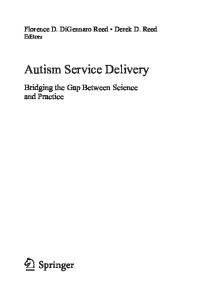Bridging the Gap between Rendering and Simulation Frameworks Concept
Taking into account aspects of semantic world models and graph databases, Nico Hempe presents concepts for a new class of modern Multi-Domain VR Simulation Systems based on the principles of the research field of eRobotics. Nico Hempe not only shows how t
- PDF / 77,819,345 Bytes
- 250 Pages / 476.22 x 680.315 pts Page_size
- 64 Downloads / 269 Views
Bridging the Gap between Rendering and Simulation Frameworks Concepts, Approaches and Applications for Modern Multi-Domain VR Simulation Systems
Bridging the Gap between Rendering and Simulation Frameworks
Nico Hempe
Bridging the Gap between Rendering and Simulation Frameworks Concepts, Approaches and Applications for Modern Multi-Domain VR Simulation Systems
Nico Hempe Aachen, Germany Dissertation RWTH Aachen, 2015 D 82
ISBN 978-3-658-14400-5 ISBN 978-3-658-14401-2 (eBook) DOI 10.1007/978-3-658-14401-2 Library of Congress Control Number: 2016941075 Springer Vieweg © Springer Fachmedien Wiesbaden 2016 This work is subject to copyright. All rights are reserved by the Publisher, whether the whole or part of the material is concerned, specifically the rights of translation, reprinting, reuse of illustrations, recitation, broadcasting, reproduction on microfilms or in any other physical way, and transmission or information storage and retrieval, electronic adaptation, computer software, or by similar or dissimilar methodology now known or hereafter developed. The use of general descriptive names, registered names, trademarks, service marks, etc. in this publication does not imply, even in the absence of a specific statement, that such names are exempt from the relevant protective laws and regulations and therefore free for general use. The publisher, the authors and the editors are safe to assume that the advice and information in this book are believed to be true and accurate at the date of publication. Neither the publisher nor the authors or the editors give a warranty, express or implied, with respect to the material contained herein or for any errors or omissions that may have been made. Printed on acid-free paper This Springer Vieweg imprint is published by Springer Nature The registered company is Springer Fachmedien Wiesbaden GmbH
Foreword After nearly half a century of research, the Holy Grail of the field of computer graphics remains a comprehensive computational model and the corresponding software structure to provide realistically looking - and behaving - virtual world. However, Nico Hempe’s work, documented in this thesis achieves nothing less than a functional and proven software structure to cope with the request for realism in the ever increasing complexity of today’s robotic and mechatronic applications. Over the decades, modeling for computer simulation and visualization has progressed from an early reliance on purely geometric models to extremely powerful simulation models which also incorporate the underlying physical principles. Nico’s is to date one of the most important PhD dissertations which manage to bridge the gap between advanced simulation and comprehensive rendering techniques by combining the best of both worlds to impressive virtual reality applications. His virtual worlds, which do not only look good but serve as the basis for virtual testbeds, are key components in new development approaches in the context of eRobotics and "Industry 4.0". Starting in 2010, Nico’s work helpe











